After a long break which took about two months, Austrian football is finally back and it returned with a big game: the final of the OFB Cup. The German Bundesliga already returned two weeks ago, but this game was the first one since the coronavirus in which two teams fought for a trophy.
Additionally, it was the chance for RB Salzburg’s coach Jesse Marsch to win the first trophy in his career as a head coach. The American was already the assistant coach at RB Leipzig in the Bundesliga and the head coach of RB New York in the MLS, but he was not able to win a trophy until now.
On the other side, Austria Lustenau were the clear underdogs in this game as they are currently seventh in Austria’s second division while RB Salzburg are the best side of Austria as they also showed this season in the UEFA Champions League against Club Brugge, Napoli, and Liverpool.
In this tactical analysis, we look at both teams’ tactics and discuss the reasons for the clear 5-0 victory of RB Salzburg over Austria Lustenau. Due to this win, the team of Marsch crowned themselves the champions of the ÖFB Cup in this final.
Line-ups
Marsch lined up his team in their typical 4-4-2 formation with Cican Stankovic between the sticks and the back four in front of him consisted out of Andreas Ulmer, Maximilian Wöber, André Ramalho, and Albert Vallci (Rasmus Kristensen who joined them last summer from Ajax was once more injured). Majeed Ashimeru and Zlatko Junuzović were the central midfielders while Dominik Szoboszlai, who is linked with Chelsea, Lazio, and other top clubs, and Noah Okafor were the wingers. Up front, Patson Daka and Hee-chan Hwang were the two strikers.
On the other side, the 21-year-old Florian Eres played his first game for Lustenau since the usual keeper Domenik Schierl was suspended. In front of him, Roman Mählich used a 4-1-4-1 formation. Christian Schilling, Dominik Stumberger, Sebastian Feyrer, and Michael Lageder were the four defenders and Christoph Freitag was the lone man in front of the defence. Thomas Meyer and Alexander Ranacher were the wingers, and Daniel Tiefenbach and Pius Grabher supported Freitag in the centre. The 31-year-old Ronivaldo was the single striker.
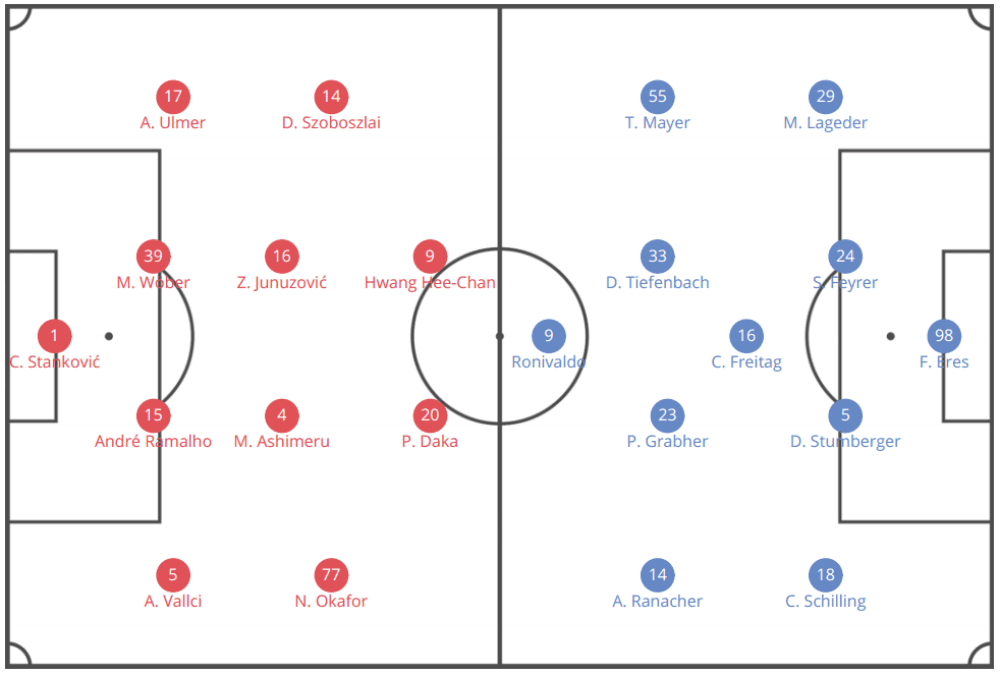
RB Salzburg’s positionings during the build-up
Before we dive in this tactical analysis into the tactics of both teams in more detail, we take a short look at the average positionings of the 20 outfield players since these will already tell us a bit about how the game went down. These can be seen in the screenshot below (credits: Wyscout).
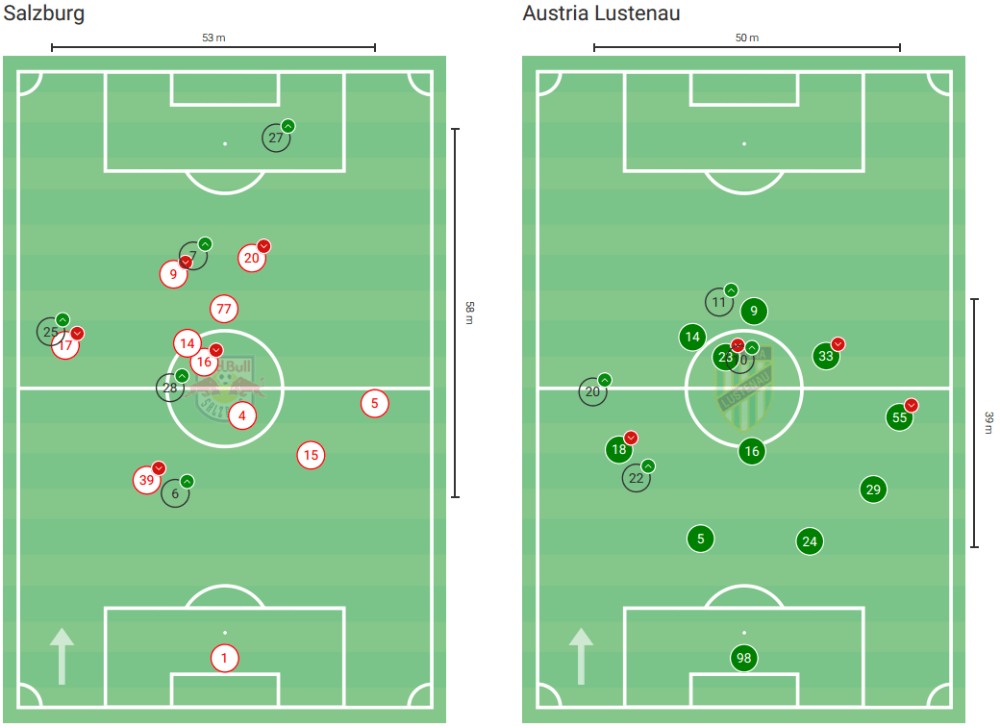
The first two aspects which get visible are that Austria Lustenau’s players were clearly positioned deeper compared to Salzburg’s and additionally they were way more vertical compact (39m vs 58m). These two aspects already tell us what was not surprising: Salzburg dominated the game with 70% of possession after the final whistle. Even though Lustenau used a high and aggressive pressing in some phases, for the majority of the game they sat back deeper in their 4-1-4-1. This switch of tactics could also be seen in their PPDA (passes per defensive action) values since, for example, during the first 15 minutes of each half they had 8.6 and 4.8 respectively, while in the period between the 30th minute and the half time whistle, a value of 24.3.
We will look at the different aspects of their defensive tactics later in this analysis, but will start now with Salzburg’s patterns during the first stage of the build-up. As we also could see in the average positioning of the players above, the full-backs constantly pushed forward (#17 Ulmer and #5 Vallci). Especially Ulmer who played more like a winger which is typical for Salzburg’s tactics while Vallci was also offensive-orientated, but stayed a bit deeper during the first stage. Ashimeru (#4) mostly dropped between the centre-backs or on the left side to build a back three as we can see below. Junuzović (#16) stayed in the centre to create a kind of a triangle which helped them massively during the build-up.
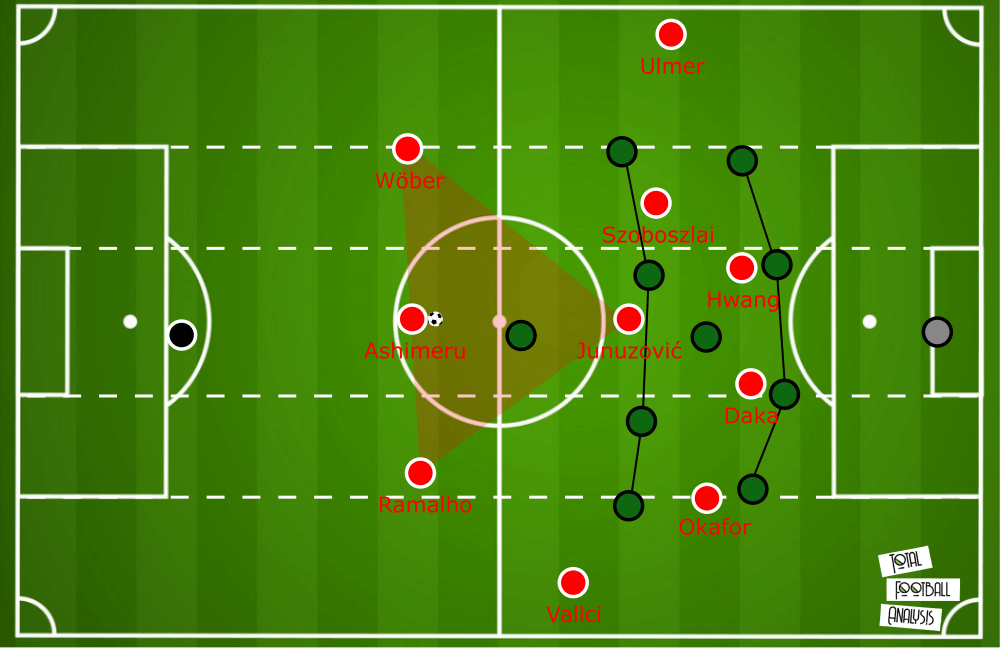
In the graphic above we can see perfectly the typical positions of the players during the build-up. This formation was especially used when Lustenau dropped deeper since, during the press, RB Salzburg often went for the long ball to then win the second ball which is typical for them. Also note in the graphic above, the central positionings of the wingers Okafor and Szoboszlai, which we will talk in more detail later in this tactical analysis.
Austria Lustenau’s 4-1-4-1
Now we will talk about the tactics of Mählich’s side out of possession. As already mentioned, they changed throughout the game between the high press and dropping back deeper. Basically, within the first 20 minutes, they put pressure on Salzburg at the latest at the height of the half-way line and then occasionally pressed higher for the remaining 25 minutes of the first half while they focused more on the low block since they wanted to avoid to conceding a third goal (the first two were scored in the 19th and 21st minute). In the shot below we can see their typical 4-1-4-1 formation and throughout the game we saw that one of the two central midfielders occasionally stepped forward to put pressure on Salzburg’s player on the ball.
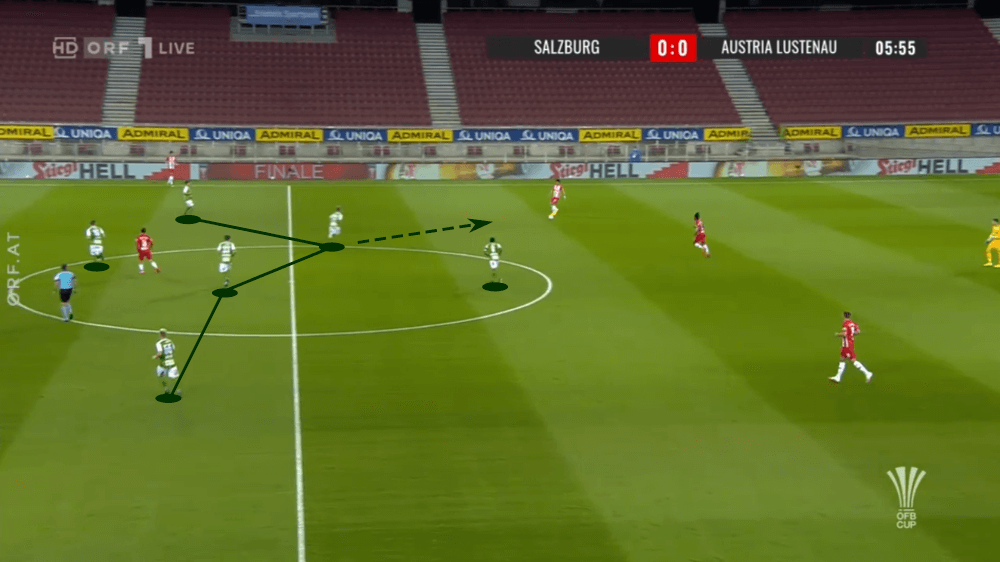
The plan to sit back a bit deeper was a quite simple and logical reaction to Salzburg’s typical tactics. With the two wingers who shifted in as well as the two central strikers, Marsch’s team had a lot of players in the centre and this is also the space where they wanted to play in as soon as possible. RBS love to get into the central area in front of the opposing defence to then use dribbles, explosive runs, and through passes to get in front of the goal.
As a reaction, Mählich switched from their usual 4-4-1-1 which they used primarily in this season to a 4-1-4-1 for this game, in order to have one additional man in the centre in front of the defence. Furthermore, they stayed extremely compact vertically and horizontally to avoid any passes through the centre. Therefore, they forced Salzburg to lay the ball to the wide-areas. As soon as the ball was played to the wing (mainly to one of the two higher positioned full-backs), Lustenau’s winger and full-back immediately shifted out to put pressure on the receiver. This can be seen in the example below in which it perfectly worked out. Also, notice again, that is one of the central midfielders who pressed Wöber and we can also see Ashimeru between the centre-backs creating a back three.
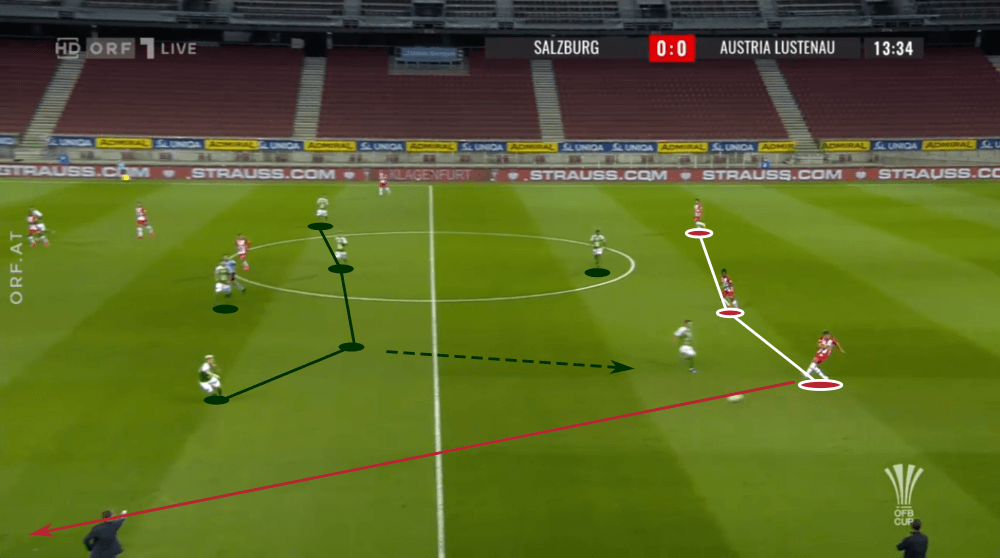
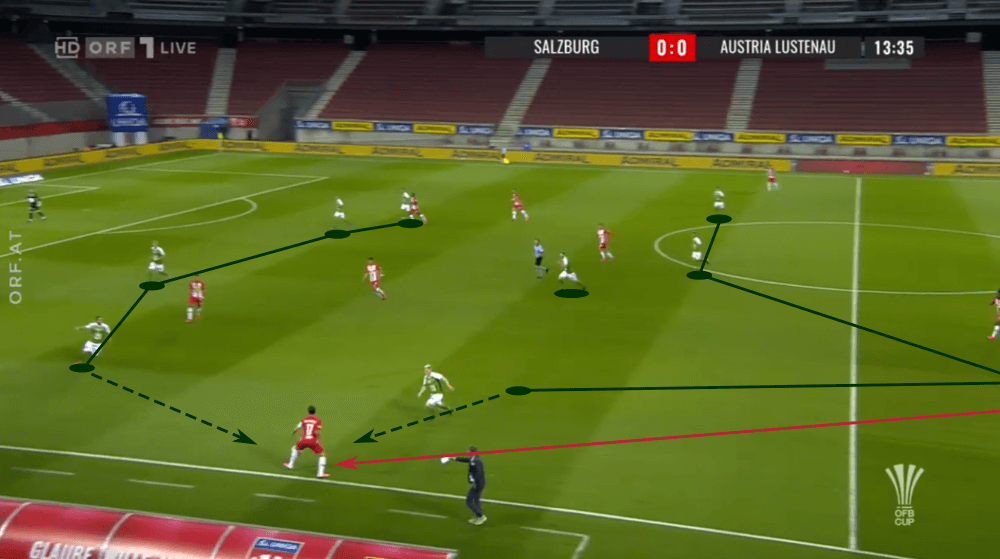
Until the first goal in the match scored in the 19th minute by Szoboszlai by a direct free-kick, Austria Lustenau showed a good performance and it was especially their aggressive press that helped them massively. The second main aspect besides the aggression which made the pressing so effective was that the whole team waited for the right moment to then together put pressure on the opponents. When Salzburg played a bad and unprecise pass or a player received a pass with the back to the actual game, these were triggers to then put pressure on the receiver.
In the shot below we have a perfect example as Junuzović receives the ball from Ulmer and has to turn to have his body orientation towards the middle of the pitch. As soon as the pass is played, the two nearest players of Lustenau sprint towards the Austrian midfielder. The defensive midfielder Freitag also steps forward to occupy the space in front of him in case Junuzović would free himself. However, Lustenau’s players were too aggressive in this situation and committed a foul.
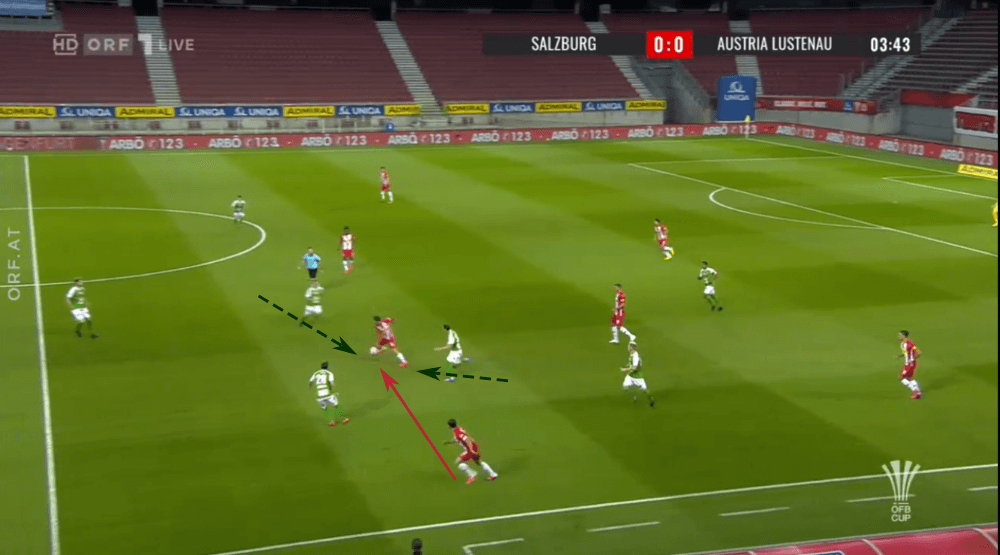
The roles of Szoboszlai and Okafor
The two wingers of Salzburg are probably the two greatest talents who currently play in Austria and they proved that in this game. Under Marsch Salzburg mainly use a 4-4-2 with wingers who tuck inside or a 3-5-2 formation which was also played several times this season. Since Szoboszlai is a player who can play on each wing and in the centre, there is always a way where he can start. However, when Salzburg bought Okafor who is a real winger, this winter transfer window, the main question which occurred was if he would fit into the system of RBS since they have no real wingers in their tactics.
However, this game showed that Okafor is also incredibly strong when he plays in the half-spaces as we will see in this part of this tactical analysis. In the shot below we have an example of a typical attack of Salzburg when Ulmer sprints down the vacant wing as Szoboszlai created this free space with the aid of his central positioning. The Hungarian then plays a simple pass to the left-back, but Ulmer’s delivery is too unprecise.
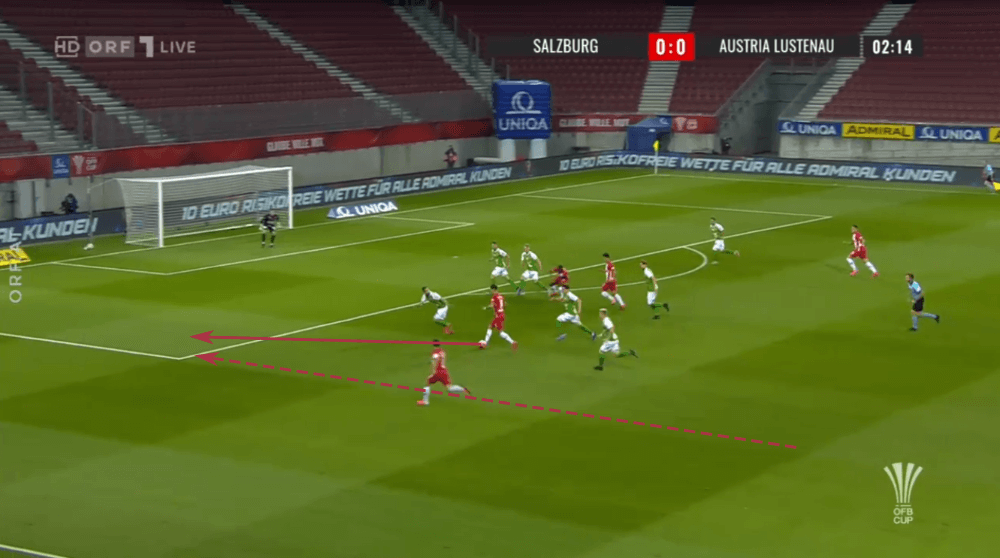
While this is one of the central parts of Salzburg’s tactics when they play in a 4-4-2 with Ulmer and the Hungarian midfielder on the left side, the question was how the players on the right wing would be positioned since Okafor is more of a natural winger while Vallci is not as offensive as Ulmer.
In half time, the two wingers swapped their positions and the tactics stayed the same. I also have to give Vallci a lot of credit as he tried to support his teammates quite often and provide width. Of course, he can’t be as confident as Ulmer yet, but he showed a decent performance especially when we focus on his offensive behaviour. In the shot below we can see a situation which sums up all these aspects as Szoboszlai and Okafor are positioned centrally and use a little combination to then find the free Vallci on the right wing.
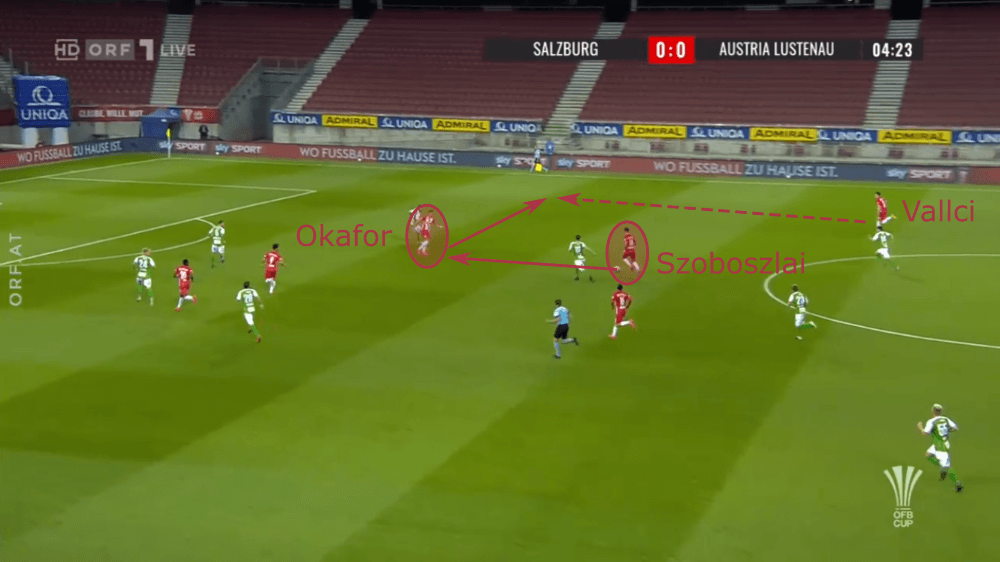
Logically, as soon as Salzburg were in front, Lustenau had to risk a bit more and therefore when they were out of possession, they were not that compact anymore. This then gave Marsch’s team more frequently the chance to find the two wingers and two strikers in the central areas. One aspect of their positioning in these moments was really good as they tried to not be in the same vertical line since then they would have eliminated each other (notice in the shot below how the four players are positioned in different lines). Also, as they overloaded this area in the middle of the pitch, the receiver of the line-breaking pass always immediately had an option for a short lay-off.
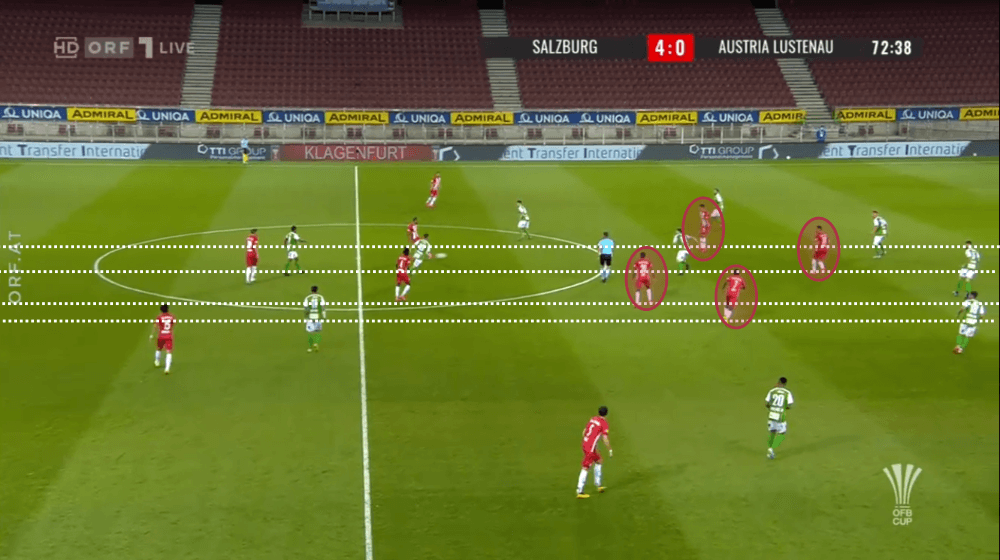
RB Salzburg’s intensity and verticality
Next, we will look at two aspects which are central parts of Salzburg’s tactics and that also got visible in this game: verticality with the ball and intensity without the ball. Whenever Marsch’s side had the ball and they were able to enter the space in front of the defence, the players without the ball immediately started the deep runs behind the opposition’s last line to provide options for through passes as we can see below. They always stayed central in these moments as this is the second central aspect of the RB philosophy, beside the verticality, when it comes to the patterns and tactics in possession.
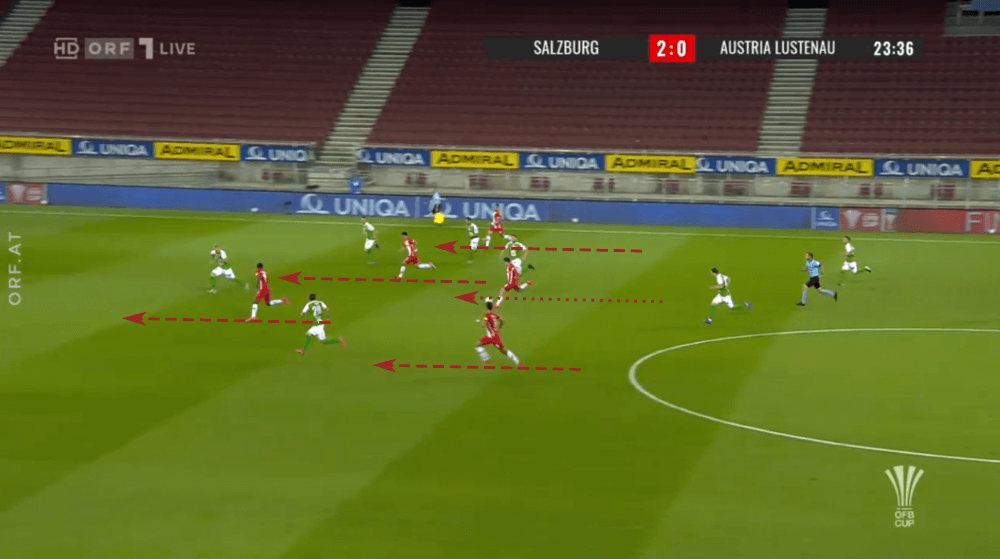
We already talked about the aspect of an aggressive and intense press quite high up the pitch that Austria Lustenau executed in some moments of the game. Of course, we also saw a high (counter-) press by Salzburg which is typical for them and one of the trademarks of the RB teams.
We will talk in the final section of this analysis about the counter-pressing and focus now on the high press. Two of their goals (the 2-0 and 3-0) resulted from their pressing as they won the ball in Lustenau’s third, and then immediately found one player in a dangerous area to score the goal and own goal, respectively.
The strikers used curved runs to force the centre-backs to a pass to the full-back who then got pressed by Salzburg’s winger. With that typical pattern, they isolated the wide-defender and brought him in a bad situation. While the full-backs were sometimes able to find in such moments the right option and solve this situation without losing the ball in the first half, this wasn’t the case in the second half due to two reasons: they were physically exhausted due to the long break due to the coronavirus and this intense match which led to worse decision-making and additionally their teammates were, due to the same reasons, not able to provide any more good passing options. In the image below we can see Salzburg’s pressing ahead of the 3-0 as the wide-defender decides to start a dribble as he has no other real options but then loses the ball as Hwang and Szoboszlai work together.
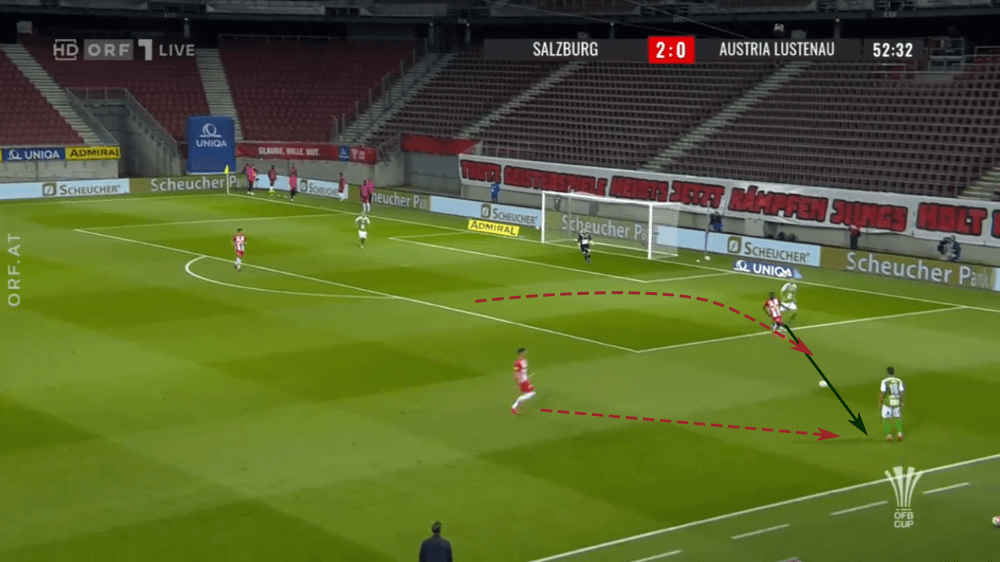
Lustenau’s problems during the offensive transition
Ashimeru showed a great performance as he often used his explosive dribbles to free himself when Austria Lustenau decided to press. Marsch’s side used either the combination of short passes or played long balls to overcome the press in these moments. Therefore, even though Lustenau’s press wasn’t that bad, Salzburg’s individual class often rescued them.
Also, the press of RBS was so effective throughout the game (with an incredible PPDA-value of four) that Lustenau mainly had to use long balls towards Ronivaldo who then was alone against Salzburg’s two centre-backs (mainly against Ramalho).
Considering these factors, the best moments for Austria Lustenau to hurt their opponents were during the offensive transition. During the counter-attacks, Ronivaldo was their target for long balls which he should then lay off as we can see in the example below.
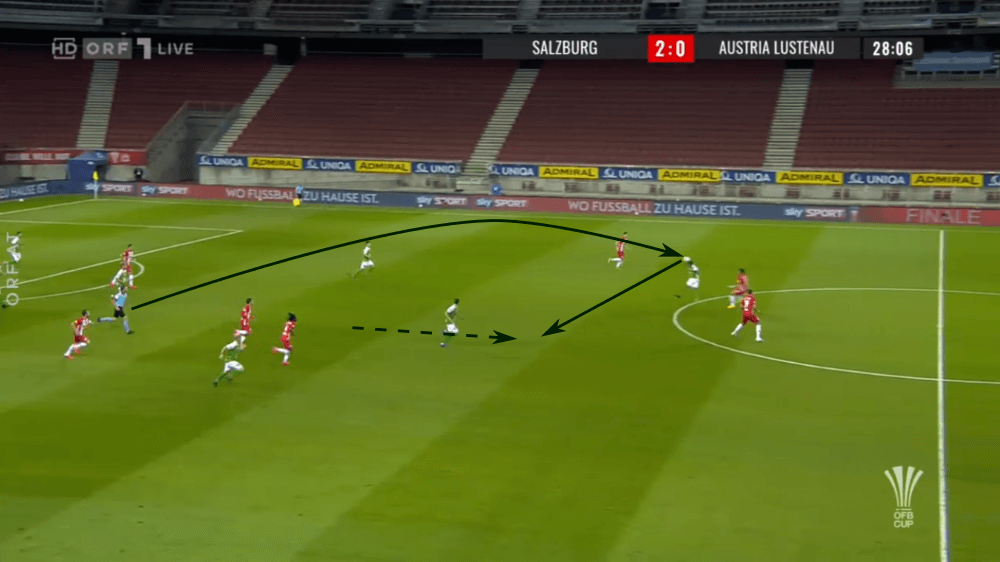
However, the intense counter-press of RB Salzburg often didn’t give Lustenau even the chance to start the counter-press. As soon as Salzburg lost the ball, the nearby players immediately sprinted towards the opponent on the ball to put pressure on him.
The greatest chance to hurt Marsch’s team is indeed to overcome the counter-press since then there is not that much rest defence. Austria Lustenau were able to do so with the combination of short passes in some moments, but then they were often so incredibly unprecise like in the situation below. In these moments, they could have really hurt Salzburg as they successfully overcame the counter-press (first image), but then the passes were often not good (second image).
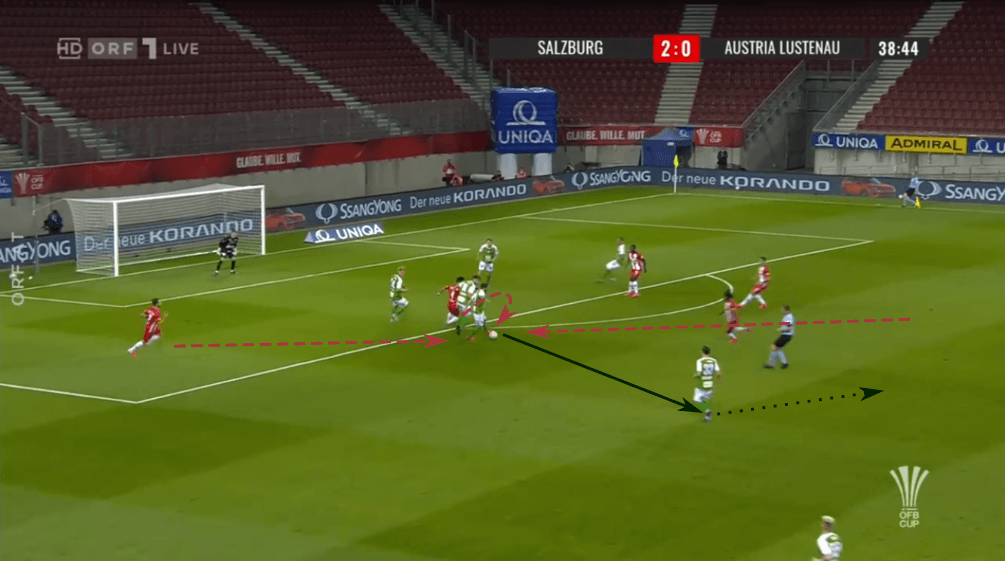
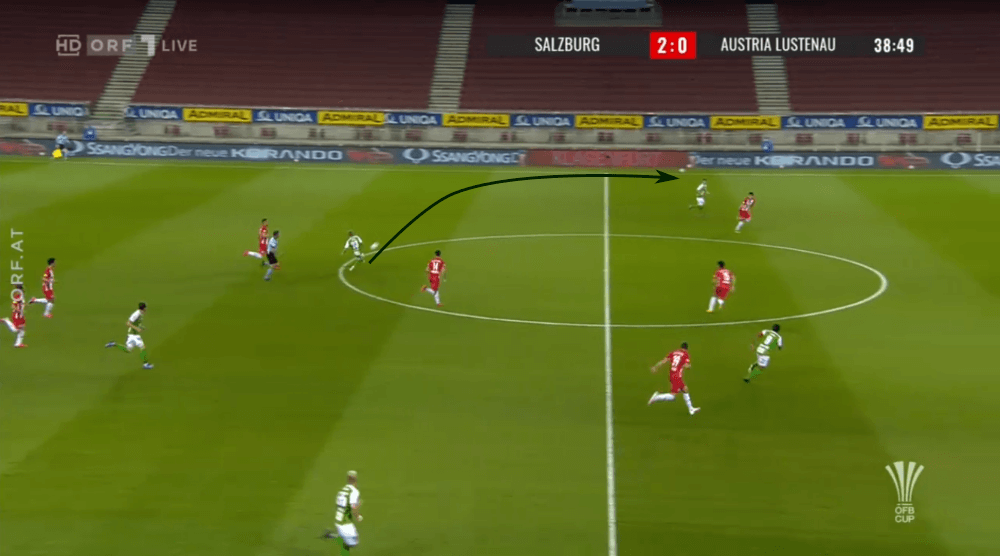
After the 90 minutes, Salzburg had an xG-value of 1.75 and Lustenau had 0.01. However, this one chance was a shot from distance by Ronivaldo which hit the crossbar. This one moment was one of the very few in which the Brazilian striker created some distance between himself and Ramalho as we can see in the shot below. This pass from Wallace then led to the only shot on goal in this whole game by Austria Lustenau.
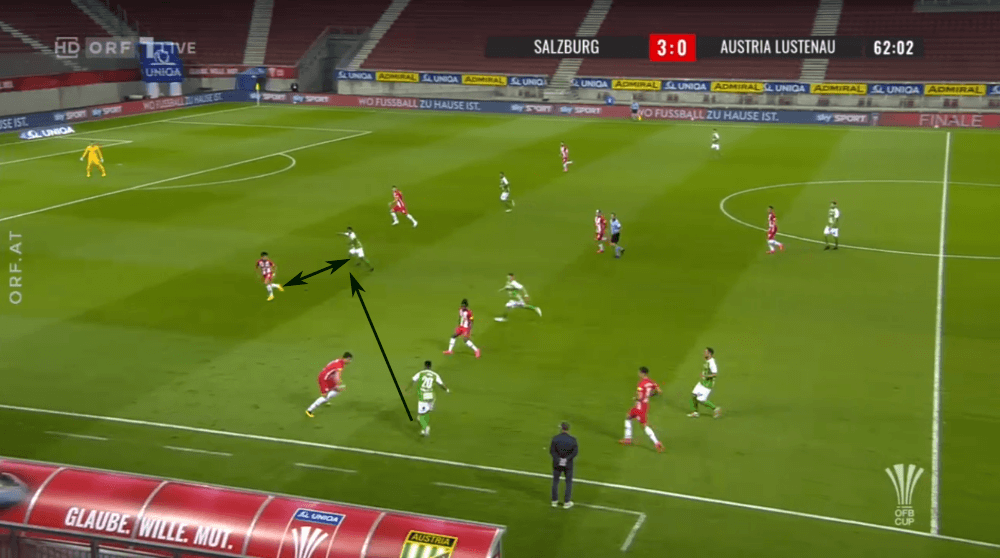
Conclusion
All in all, RB Salzburg clearly deserved the win and were the better side as they stuck with their usual tactics and we saw that Okafor is a great addition to this team. In the end, the intense press of Marsch’s side, their verticality in the final third (as well as their individual qualities), and Lustenau’s lack of precision during the offensive transition were the central factors which led to the win of Salzburg. However, I need to add here that Lustenau were quite unlucky in some situations ahead of the goals and the task of victory was way too high. This is also seen when we look at the numbers as Salzburg had an xG of 1.75 but scored five goals.
It will be interesting to see how RB Salzburg will perform in the remaining games in the Austrian Bundesliga as they want to win the domestic double and are currently three points ahead of LASK Linz while there are 10 more games to go.





Comments